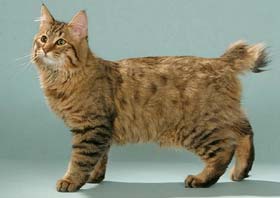Origin and History
The Pixie-Bob cat breed, characterized by its wild appearance and domestic temperament, has an intriguing history. This breed’s journey began in the Northwestern United States in the mid-1980s. Carol Ann Brewer, a cat enthusiast and breeder, played a pivotal role in the creation of the Pixie-Bob. In 1985, Brewer acquired a unique male kitten with a short tail and polydactyl feet (extra toes), which is a rare trait among cats. This male kitten, believed to be a result of natural bobcat and domestic cat breeding, sparked Brewer’s interest in developing a new breed.
The foundation of the breed was solidified with the birth of a kitten named Pixie, who exhibited many of the desired traits Brewer sought. Pixie became the cornerstone of Brewer’s breeding program. By 1989, Brewer had established a breeding standard, and in 1993, she approached The International Cat Association (TICA) for recognition. The breed gained championship status in 1997, marking its official acceptance and paving the way for its popularity.
Unique Characteristics
Pixie-Bobs are known for their distinctive appearance, which mirrors that of the wild Coastal Red Bobcat. They have a robust and muscular build, with a heavy bone structure and a characteristic rolling gait. These cats are medium to large in size, with males typically weighing between 12 and 17 pounds and females ranging from 8 to 12 pounds.
One of the most notable features of the Pixie-Bob is its coat, which comes in two varieties: shorthair and longhair. Both types have a dense, double-layered coat that stands away from the body, giving it a padded appearance. The coat is usually brown spotted tabby in color, with shades ranging from tawny to reddish-brown. The texture of the coat is woolly in shorthairs and softer in longhairs.
Another distinctive trait is their facial structure. Pixie-Bobs have a pear-shaped face with a strong, fleshy chin, puffy nose leather, and heavy brows that give them a serious expression. Their eyes are medium-sized, triangular, and can be golden brown to gooseberry green. Additionally, some Pixie-Bobs have lynx-like ear tufts and downward-growing facial hair that resembles muttonchop sideburns.
Personality and Behavior
Despite their wild looks, Pixie-Bobs are known for their affectionate and loyal nature. They are often described as having dog-like personalities due to their strong attachment to their human families and their trainability. These cats are intelligent, curious, and enjoy interactive play. They can be trained to walk on a leash, fetch, and perform other tricks, making them excellent companions for active households.
Pixie-Bobs are social animals that get along well with children and other pets. They are known for their gentle and patient demeanor, making them ideal family pets. These cats are not particularly vocal but communicate through a range of sounds, including chirps, chitters, and occasional growls.
Care and Maintenance
Owning a Pixie-Bob requires commitment to regular grooming and overall care to ensure their health and well-being. Their dense double coat, particularly in the longhaired variety, needs regular brushing to prevent matting and reduce shedding. Weekly brushing is typically sufficient for shorthairs, while longhairs may require more frequent grooming.
In addition to coat care, Pixie-Bobs need regular nail trimming, ear cleaning, and dental care. Brushing their teeth several times a week helps prevent dental disease, which is common in many cat breeds. Regular veterinary check-ups are essential to monitor their health and catch any potential issues early.
Health and Lifespan
Pixie-Bobs are generally healthy cats with a lifespan of 13 to 15 years. However, like all breeds, they can be prone to specific health issues. Some common concerns include hypertrophic cardiomyopathy (a form of heart disease), hip dysplasia, and cryptorchidism (undescended testicles). Responsible breeders screen for these and other genetic conditions to ensure the health of their breeding cats and kittens.
A balanced diet and regular exercise are crucial for maintaining the health of a Pixie-Bob. These cats have a muscular build and can become overweight if not properly exercised. Interactive play and activities like leash walking can help keep them fit and mentally stimulated.
Training and Socialization
One of the standout traits of Pixie-Bobs is their trainability. These cats can be taught various tricks and commands, making them unique among domestic cat breeds. Early socialization and training are key to developing a well-behaved Pixie-Bob. Positive reinforcement techniques, such as treats and praise, work well with this intelligent breed.
Socializing Pixie-Bobs from a young age helps them become well-adjusted adults. Exposure to different environments, people, and other animals can reduce the likelihood of shyness or aggression. This breed thrives on interaction and mental stimulation, so providing plenty of toys, puzzles, and interactive playtime is essential.
Breeding Standards and Recognition
The Pixie-Bob breed has specific standards that breeders aim to meet. According to TICA, the ideal Pixie-Bob should have a muscular build, a short or bobbed tail, and a dense coat with a spotted pattern. Polydactylism is accepted and can be a desirable trait, with a maximum of seven toes allowed.
Breeding Pixie-Bobs requires careful selection to maintain the breed’s unique characteristics while ensuring genetic diversity and health. Responsible breeders follow ethical breeding practices, including health screenings and proper care of breeding cats and kittens.
Conclusion
The Pixie-Bob cat breed is a captivating blend of wild appearance and domestic charm. With their robust build, distinctive coat, and affectionate personality, they make excellent companions for those looking for a unique and loyal pet. Proper care, regular grooming, and early training are essential to ensure a happy and healthy Pixie-Bob.
By understanding the origins, characteristics, and care requirements of the Pixie-Bob, potential owners can provide a loving and suitable environment for this extraordinary breed. Whether you’re drawn to their wild looks or their dog-like devotion, Pixie-Bobs are sure to leave a lasting impression on any cat lover.

